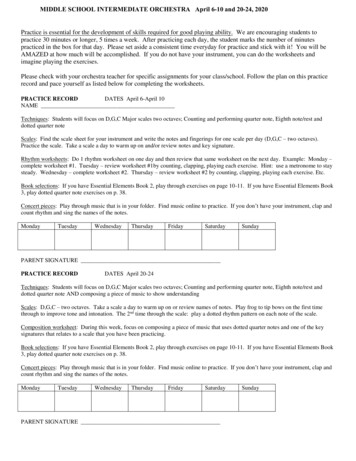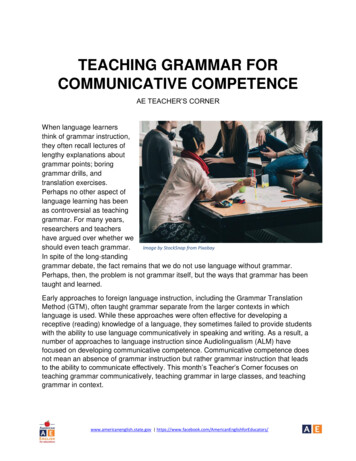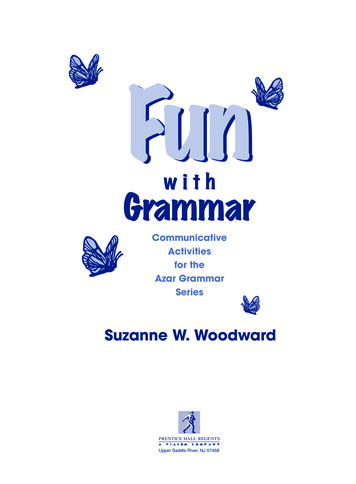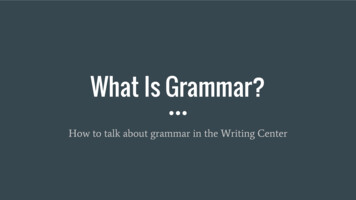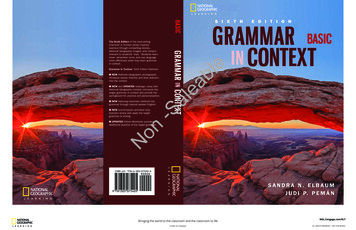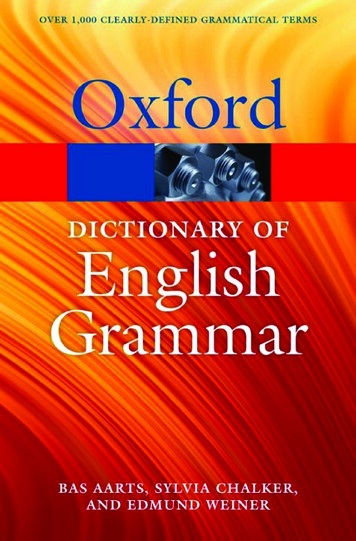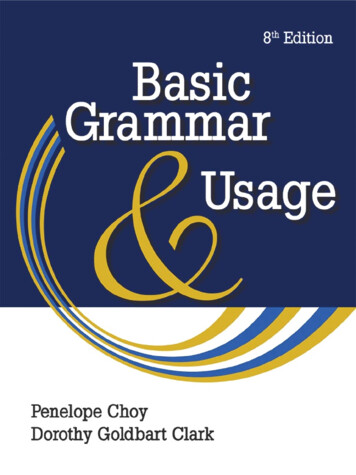
Transcription
The Verb To Be (The Most Common Linking Verb)Present Tense: I amyou arehe/she/it iswe areyou arethey arePast Tense:I wasyou werehe/she/it waswe wereyou werethey wereFrequently Used ofonontooutoverthroughtotowardunderHelping VerbsHelping Verbs Sometimescan,couldmay, might, mustshall, shouldhas, have, haddoes, do, did, doneam, is are, was, were, beenupuponwithwithinwithout(forms of to have)(forms of to do)(forms of to be)Coordinating Conjunctionsandsobutoryetnorfor (when it means because)Conjunctive Adverbsactuallyalsoanywayas a resultbesidesconsequentlyconverselyfinallyfor examplefor instancefor this reasonfurthermorehencehoweverin additionincidentallyindeedin factin essnonethelesson the other rethusAdverb Clause Subordinating Conjunctionsafteralthoughasas ifas long asas soon asthoughbecausebeforeeven ifeven thoughifin order thatonceprovided thatsinceso erwhile
Basic Grammar and UsageEighth EditionPenelope ChoyLos Angeles City College, EmeritaDorothy Goldbart ClarkCalifornia State University, NorthridgeAustralia Brazil Japan Korea Mexico Singapore Spain United Kingdom United States
Basic Grammar and Usage, Eighth EditionPenelope Choy, Dorothy Goldbart ClarkDevelopment Editor: Cathylnn RichardDodsonAssistant Editor: Janine TangneyEditorial Assistant: Melanie OpackiMarketing Manager: Kirsten StollerMarketing Communications Manager:Martha PfeifferArt Director: Jill OrtPrint Buyer: Denise PowersPermissions Editor: MargaretChamberlain-Gaston 2011, 2006, 2002 Wadsworth, Cengage LearningALL RIGHTS RESERVED. No part of this work covered by the copyrightherein may be reproduced, transmitted, stored or used in any form or byany means graphic, electronic, or mechanical, including but not limited tophotocopying, recording, scanning, digitizing, taping, Web distribution,information networks, or information storage and retrieval systems, exceptas permitted under Section 107 or 108 of the 1976 United States CopyrightAct, without the prior written permission of the publisher.For product information and technology assistance, contact us atCengage Learning Customer & Sales Support, 1-800-354-9706For permission to use material from this text or product,submit all requests online at cengage.com/permissionsFurther permissions questions can be emailed topermissionrequest@cengage.comProduction Service: Pre-PressPMGCover Designer: Steve SchirraCompositor: Pre-PressPMGLibrary of Congress Control Number: 2009941321ISBN-13: 978-1-4282-1155-1ISBN-10: 1-4282-1155-1Wadsworth20 Channel Center StreetBoston, MA 02210USACengage Learning is a leading provider of customized learning solutions withoffice locations around the globe, including Singapore, the United Kingdom,Australia, Mexico, Brazil, and Japan. Locate your local office at:international.cengage.com/regionCengage Learning products are represented in Canada byNelson Education, Ltd.For your course and learning solutions, visit www.cengage.comPurchase any of our products at your local college store or at our preferredonline store www.CengageBrain.comPrinted in the United States of America1 2 3 4 5 6 7 13 12 11 10 09
CONTENTSPreface to the Eighth EditionPreface to the First EditionviixiUNIT 1Identifying Subjects and Verbs1Chapter 1Sentences with One Subject and One Verb3Chapter 2Multiple Subjects and Verbs15Chapter 3Distinguishing Between Objects ofPrepositions and Subjects23Chapter 4Main Verbs and Helping VerbsUnit 1 Review3341UNIT 2Subject–Verb Agreement43Chapter 5Recognizing Singular and Plural Subjectsand Verbs45iii
ivContentsChapter 6Indefinite Pronouns as Subjects55Chapter 7Subjects Understood in a Special Sense63Chapter 8Subjects Joined by ConjunctionsUnit 2 Review6975UNIT 3Identifying and Punctuating the Main Typesof Sentences77Chapter 9Compound Sentences79Chapter 10Complex Sentences95Chapter 11Avoiding Run-On Sentences and Comma Splices107Chapter 12Correcting FragmentsUnit 3 Review117127UNIT 4Punctuation That “Sets Off” or SeparatesChapter 13Parenthetical Expressions133131
ContentsChapter 14Appositives147Chapter 15Restrictive and Nonrestrictive Clauses159Chapter 16Commas with Introductory Phrases, Series, Dates,and Addresses175Unit 4 ReviewUNIT 5Pronoun Usage187191Chapter 17Subject, Object, and Possessive Pronouns193Chapter 18Pronouns in Comparisons and Pronounswith -self, -selves203Chapter 19Agreement of Pronouns with Their Antecedents211Chapter 20Order of Pronouns and Spelling of PossessivesUnit 5 Review229221v
viContentsUNIT 6Capitalization, Additional Punctuation,Placement of Modifiers, Parallel Structure,and Irregular Verbs231Chapter 21Capitalization233Chapter 22Additional Punctuation241Chapter 23Misplaced and Dangling ModifiersChapter 24Parallel Structure261Chapter 25Irregular Verbs273Unit 6 Review287UNIT 7Paragraphs293Chapter 26Writing Effective ParagraphsAnswers to “A” ExercisesIndex335317295251
PREFACE TO THEEIGHTH EDITIONMore than thirty years have passed since Penelope Choy wrote the first edition of Basic Grammar and Usage in 1978. She and Dorothy Clark, who hasbeen a coauthor of this text since the fourth edition, are gratified that instructors continue to use our book.As in previous revisions, the eighth edition includes new exercises for each chapter, along with a few of the authors’ favorite exercises from previous editions. At thesuggestion of instructors, Units 3 and 4 now include separate exercises that requirestudents to compose their own sentences, using the structures discussed in eachchapter (for example, compound sentences, parenthetical expressions, or restrictiveand nonrestrictive clauses). In Unit 6, students are also asked to write sentencesusing parallel structure and correctly positioned modifiers. The section on apostrophes has also been rewritten and expanded.The eighth edition retains the chapter on composing paragraphs that firstappeared in the seventh edition. This chapter, written by Dorothy Clark, hasbeen revised and now includes examples of paragraphs written by her studentsfor users of this book to analyze.This eighth edition of Basic Grammar and Usage preserves the format of theearlier editions. The text contains six grammar units, beginning with the unit onsubject-verb identification, which forms the foundation for the rest of the book.It continues with five other units devoted to specific areas of grammar, such assubject-verb agreement or pronoun usage. Each unit is divided into four or fiveshort chapters to make acquisition of the material easier for the students. Eachchapter includes clear explanations of grammar rules and structures and provides copious examples for each point. Short exercises for each new grammarpoint occur throughout every chapter.At the end of each chapter are two (and in some units, three) exercises.Exercise A covers only the material presented in that chapter. Exercise B reviewsmaterial covered in earlier chapters in that particular unit to ensure that students remember what they have previously studied and are able to see the relationships among the various chapters. For example, in Chapter 13 studentsbegin by learning what a parenthetical expression is and how to punctuate it. InChapter 14 they are introduced to appositives, which are punctuated in the sameway. Having mastered appositives, the students move on in Chapter 15 to restrictive and nonrestrictive clauses. This usually challenging topic is made easierbecause the students can now see the adjective clause as an expansion of information contained in an appositive, and they already know the punctuation rulefor separating words that contain “extra” information from the sentences invii
viiiPreface to the Eighth Editionwhich they occur. “C” exercises require students to compose their own sentences, such as writing one sentence using who in a restrictive clause and anotherusing who in a nonrestrictive clause.To help in holding the students’ interest, most of the “A” and “B” exercisesare written in narrative form on a wide variety of topics. A comprehensive reviewexercise at the end of each unit tests the students’ knowledge of the entire sequenceof lessons for that unit. All of the exercises are on perforated pages that thestudents can remove from the book. Answers to the “A” exercises are printed inthe appendix so that the students can check their own work. Answers to the “B”exercises appear only in the Instructor’s Manual so that these exercises can beassigned as homework. The Instructor’s Manual is described in more detail below.Except for Unit 1, which involves identifying subjects and verbs in a sentence, we have tried to include exercises that emphasize recognizing and correcting errors. This emphasis on error correction reflects our belief that a primaryreason for studying grammar and usage is to help students learn to correct errorsin their own writing, and, ultimately, to avoid making these mistakes in thefuture. For this reason, many of the chapters include not just single-sentenceitems for the students to correct but short, multi-paragraph essays that the students proofread for a particular kind of error.An Instructor’s Manual is available to anyone who adopts this book. Besidesthe answers to the “B” exercises, the manual contains three different sets oftests. Detailed unit tests provide the instructor with ready-to-photocopy examsfor each section of the book. Brief, but comprehensive, diagnostic tests for everyunit in the book can be used to measure how much the students already knowabout grammar at the beginning of the course. Instructors who do not plan tocover the entire book can also use these tests to determine which units their students need to study. Achievement tests, which are identical in format to thediagnostic tests, measure what the students have learned after completing thecourse and may be used as a final exam. (By “identical in format,” we mean thatitem number one on the diagnostic test for Unit One covers the same grammarrule as item number one on the achievement test. Therefore, the instructor cansee exactly which points of grammar students have learned or failed to learnduring the semester.) These tests are printed on eight and a half by eleven perforated pages for convenient reproduction, and answers for each exam are includedin the manual. We suggest that the diagnostic tests be given at the very beginning of the course and that the achievement tests be given at the end. If instructors prefer to prepare their own exams, the tests in the Instructor’s Manual maybe used for extra practice.Although Basic Grammar and Usage was originally designed for students whosenative language is English, it has also been used by students learning English as asecond language. In addition to being a classroom text, Basic Grammar and Usagecan also be used in writing centers and for individual study.
Preface to the Eighth EditionixMany people have participated in the preparation of this book. We are particularly grateful to the instructors who reviewed our text and who suggestedrevisions for this edition:Amye Howell, Copiah-Lincoln Community CollegeShiloh Winsor, Grays Harbor CollegeDee Robbins, Black Hawk CollegeMary Beth Spore, Saint Vincent CollegeKathleen M. Fritsch, Dawson Community CollegeLawrence Barkley, Mt. San Jacinto College Menifee Valley CampusDr. Ann Marie Prengaman, Lane Community CollegePajer, Gonzaga UniversityNicole Donald, Copiah-Lincolin Community CollegeKathryn Henkins, Mt. San Antonio CollegeRuth Ochoa, Sacramento City CollegeJane Perry, Norwalk Community CollegeRolando Jorif, Borough of Manhattan Community CollegeWe would also like to thank the following people who oversaw the production of this book.Publisher: Lyn UhlDirector of Developmental English: Annie ToddDevelopment Editor: Cathylnn Richard DodsonAssociate Editor: Janine TangneyEditorial Assistant: Melanie OpackiAssociate Media Editor: Emily RyanMarketing Manager: Kirsten StollerMarketing Assistant: Ryan AhernImage Permissions Acquisitions Manager: Amanda GroszkoText Permissions Manager: Margaret Chamberlain-GastonMedia Project Manager: Ronda RobinsonManufacturing Director: Denise PowersProduction Manager: Samantha Ross MillerProduction Coordinator: Margaret BridgesArt Director: Jill OrtProduct Project Manager: Prashanth KamavarapuImage Researcher: John HillPenelope Choy would like to thank the students she encountered during herforty-one years of teaching English and ESL. Their many questions about Englishgrammar inspired her to write the first and subsequent editions of this book. Sheis also grateful to the instructors at Los Angeles City College who used BasicGrammar and Usage during the thirty-two years she taught there. Her stepson,Joel Rothman, who taught her to use a computer many years ago, showed her
xPreface to the Eighth Editionhow to use a CD for this version. For his constant support in every area of herlife, Penny is grateful to her husband, Gene Rothman, whose patience and goodhumor are especially appreciated when she has writing deadlines to meet.Dorothy Clark would like to thank her husband, Kevin O’Neill, for his constant, loving support and creative encouragement; her children, Julia and Ben,for the inspiration they offer; and her students, for the lessons they continue toteach her.Both of us would like to thank the hundreds of instructors and the thousands of students who have used Basic Grammar and Usage during the pastfour decades. We know personally the relief students feel when they realize thatEnglish grammar is comprehensible and that it can be studied systematically. Wehope that your students have similarly successful experiences.
PREFACE TO THEFIRST EDITIONBasic Grammar and Usage was originally written for students in a specialadmissions program at the University of California, Los Angeles. As part oftheir participation in the program, the students were enrolled in a compositionand grammar course designed to prepare them for the university’s freshmanEnglish courses. When the program began in 1971, none of the grammar textbooks then on the market seemed suitable for the students, whose previousexposure to grammar had been cursory or, in some cases, nonexistent. As thedirector of the program’s English classes, I decided to write a book of my ownthat would cover the most important areas of grammar and usage in a way thatwould be easily understood by my students.The original version of Basic Grammar and Usage received an enthusiasticresponse from the students and was used successfully throughout the threeyear duration of the program. After the program ended in 1974, many of theinstructors asked permission to reproduce the book for use in their new teaching positions. By the time copies of Basic Grammar and Usage reached HarcourtBrace Jovanovich in 1975, the text had already been used by more than 1,500students in nearly a dozen schools.Basic Grammar and Usage presents material in small segments so that students can master a particular topic one step at a time. The lessons within eachunit are cumulative. For example, students doing the pronoun exercises for Lesson19 will find that those exercises include a review of the constructions treated inLessons 16 to 18. This approach reinforces the students’ grasp of the material andhelps them develop the skills they need for the writing of compositions. To makethem more interesting to students, the exercises in four of the six units arepresented as short narratives rather than as lists of unrelated sentences. Eachlesson concludes with two exercises, which may be either used in class orassigned as homework. In addition, each unit ends with a composition that thestudents must proofread for errors and then correct to demonstrate mastery ofthe material.Students who have never before studied grammar systematically will find thatworking through the text from beginning to end provides an insight into the basicpatterns of English grammar. As one student commented on an end-of-course evaluation, “The most important thing I learned from Basic Grammar and Usage is that ifyou learn what an independent clause is, half of your grammar problems are over.”On the other hand, students who do not need a total review of grammar can concentrate on the specific areas in which they have weaknesses. To help the instructorevaluate both types of student, the Instructor’s Manual accompanying the textxi
xiiPreface to the First Editionincludes a diagnostic test and a post-test divided into sections corresponding to theunits in the book. There are also separate achievement tests for each unit, as well asanswer keys to the exercises presented in the text.Although Basic Grammar and Usage is designed for students whose nativelanguage is English, it has been used successfully by students learning English asa second language. In addition to being a classroom text, Basic Grammar andUsage can be used in writing labs and for individual tutoring.Many people have shared in the preparation of Basic Grammar and Usage.I wish in particular to thank the instructors and administrators of UCLA’sAcademic Advancement Program, where this book originated. In revising thetext for publication, I have been greatly helped by the suggestions of ReginaSackmary of Queensborough Community College of the City University ofNew York and by Elizabeth Gavin, formerly of California State University,Long Beach, who reviewed the manuscript for me. Sue Houchins of the BlackStudies Center of the Claremont Colleges contributed many ideas and referencematerials for the exercises. An author could not ask for more supportive peopleto work with than the staff of Harcourt Brace Jovanovich. I owe a special debtof gratitude to Raoul Savoie, who first brought the UCLA version of the text tothe attention of his company. I also wish to thank Lauren Procton, who wasresponsible for the editing, and Eben W. Ludlow, who has provided guidanceand encouragement throughout all the stages of this book’s development.Penelope Choy
U1NITIdentifying Subjectsand Verbs
This page intentionally left blank
CHA1PTERSentences with One Subjectand One VerbThe most important grammatical skill you can learn is how to identifysubjects and verbs. Just as solving arithmetic problems requires thatyou know the multiplication tables perfectly, solving grammaticalproblems requires you to identify subjects and verbs with perfect accuracy. This is not as difficult as it may sound. With practice, recognizingsubjects and verbs will become as automatic as knowing that 2 2 4.Although in conversation people often speak in short word groups that maynot be complete sentences, in writing it is customary to use complete sentences.A complete sentence contains at least one subjectand one verb.A sentence can be thought of as a statement describing an actor performing aparticular action. For example, in the sentence “The dog ran,” the actor or personperforming the action is the dog. What action did the dog perform? He ran. This3
4Chapter 1actor–action pattern can be found in most sentences. Can you identify the actorand the action in each of the following sentences?The teacher laughed.The crowd applauded.The actor in a sentence is called the subject. The action word in a sentence iscalled the verb. Together, the subject and the verb form the core of the sentence.Notice that even if extra words are added to the two sentences above, thesubject–verb core in each sentence remains the same.The teacher laughed at the student’s joke.After the performance, the crowd applauded enthusiastically.You can see that to identify subjects and verbs, you must be able to separatethese core words from the rest of the words in the sentence.Here are some suggestions to help you identify verbs.1. The action words in sentences are verbs. For example,The team played well.This store sells rare books.The doctor recommended vitamins.Underline the verb in each of the following sentences.The bank lends money to small businesses.Gina speaks Italian.The flood destroyed many homes.2. All forms of the verb “to be” are verbs: am, is, are, was, were, and been. Forexample,Susan is unhappy.The actor was nervous.Verbs also include words that can be used as substitutes for forms of be,such as seem, feel, become, and appear. These verbs are called linking verbs.Susan seems unhappy.The actor appeared nervous.
Sentences with One Subject and One Verb5Underline the verb in each of the following sentences.The children became excited during the birthday party.The professor seemed fatigued today.The actors felt happy with their performances.3. Verbs are the only words that change their spelling to show tense. Tense isthe time—present, past, or future—at which the verb’s action occurs. Forexample, the sentence “We walk each morning” has a present-tense verb.The sentence “We walked each morning” has a past-tense verb. Underlinethe verb in each of the following sentences.Grandfather moves today.My brother moved to Chicago last month.Sandra dances very well.Maria danced on her wedding day.I wash my hair every morning.The nurse washed her hands.Identifying verbs will be easier for you if you remember that the followingkinds of words are not verbs.4. An infinitive—the combination of the word to plus a verb, such as to walkor to study—is not considered part of the verb in a sentence. Read the following sentences.He plans to swim later.She wants to enter graduate school.The main verbs in these two sentences are plans and wants. The infinitivesto swim and to enter are not included. Underline the main verb in each of thefollowing sentences.Benjy decided to play his new video games.The conductor promised to check our luggage.5. Adverbs—words that describe a verb—are not part of the verb. Manycommonly used adverbs end in -ly. The adverbs in the following sentencesare italicized. Underline the verb in each sentence.
6Chapter 1The guitarist played badly.Phillipe rushed quickly to our rescue.The mother patiently helped her children.The words not, never, and very are also adverbs. Like other adverbs, thesewords are not part of the verb. Underline the verb in each of the followingsentences. Do not include adverbs.The dancers are not here yet.He never studies for his tests.The director spoke very carefully.He is not a good mechanic.José never remembers to close the door.Now that you can identify verbs, here are some suggestions to help youidentify subjects.1. The subject of a sentence is most often a noun. A noun is the name of a person, place, or thing, such as Julia, Houston, or pens. A noun may also be thename of an abstract idea, such as sadness or failure. Underline the subject ineach of the following sentences once and the verb twice. Remember that theverb is the action, and the subject is the actor.Kevin reads many books each month.The store closes at midnight.Athens hosted the 2004 Summer Olympics.Love conquers all.2. The subject of a sentence may also be a subject pronoun. A pronoun is aword used in place of a noun, such as she ( Julia), it ( Houston), or they( pens). The following words are subject pronouns:I, you, he, she, it, we, theyUnderline the subject in each of the following sentences once and the verb twice.He was elected president of the United States.Each spring they travel to Yosemite National Park.I always drink strong coffee.
Sentences with One Subject and One Verb7We rarely have dinner out on weekdays.You washed the dishes last night.3. The subject of a sentence may also be a gerund. A gerund is an -ing form of averb used as a noun. For example, in the sentence “Swimming is an excellentform of exercise,” the subject of the sentence is the gerund swimming. Underlinethe gerund subjects in the following sentences once and the verbs twice.Listening is difficult for young children.Dieting makes me very hungry.4. In commands (also known as imperatives), such as “Wash the dishes!”, thesubject is understood to be the subject pronoun you even though the wordyou is almost never included in the command. You is understood to be thesubject of the following sentences:Do your homework early.Consider the alternative.Underline the subject in each of the following sentences once and the verbtwice. If the sentence is a command, write the subject you in parentheses at thebeginning of the sentence.Remember to wipe your feet before entering.The judge reviewed the verdict.They bowl every Wednesday.Discuss these issues with your colleagues.Identifying subjects will be easier for you if you remember that the followingkinds of words are not subjects.5. Adjectives—words that describe a noun—are not part of the subject. Forexample, in the sentence “The tall boy runs well,” the subject is “boy,” not“tall boy.” In the sentence “A new car is a great joy,” the subject is “car,”not “new car.” Underline the subject in each of the following sentences onceand the verb twice.A talented singer performed that song.Chocolate cake is his favorite food.
8Chapter 1Small pets delight our family.An angry, bitter debate ended the program.6. Words that show possession, or ownership, are not part of the subject.Words that show possession include nouns ending in an apostrophe (’) combined with s, such as Dina’s or cat’s. They also include possessive pronouns,words that replace nouns showing ownership, such as hers ( Dina’s) or its( cat’s). Possessive pronouns include the following words:my, your, his, hers, its, our, theirBecause words that show possession are not part of the subject, in thesentence “My dog has fleas,” the subject is “dog,” not “my dog.” In the sentence“Sarah’s mother is a doctor,” the subject is “mother,” not “Sarah’s mother.”Underline the subject in each of the following sentences once and the verb twice.His daughter became a doctor.My brother works in another city.This beach’s beauty is startling.Harry’s car needs a new battery.Here is a final suggestion to help you identify subjects and verbs accurately.Try to identify the verb in a sentence before you try to identifythe subject.A sentence may have many nouns, any of which could be the subject, but it willusually have only one or two verbs. For example,The director of the play shouted angry words to all the actors and staff.There are five nouns in the above sentence (director, play, words, actors, staff ),any of which might be the subject. However, there is only one verb—shouted.Once you have identified the verb as shouted, all you have to ask yourself is,“Who or what shouted?” The answer is director, which is the subject of thesentence.Identify the subject and verb in the following sentence, remembering to lookfor the verb first.In the winter, our family travels to the mountains for our vacation.
Sentences with One Subject and One Verb9Remember these basic points:1. The action being performed in a sentence is the verb.2. The person or thing performing the action is the subject.3. A sentence consists of an actor performing an action, or, in other words, asubject plus a verb.Every sentence you write will have a subject and a verb, so you must be ableto identify subjects and verbs to write correctly. Therefore, as you do the exercises in this unit, apply the rules you have learned in each lesson, and thinkabout what you are doing. Do not make random guesses. Grammar is based onlogic, not on luck.Underline the subject in each of the following sentences once and the verbtwice. Add the subject you in parentheses if the sentence is a command.That man won the contest yesterday.Success makes us happy.The ancient horse slowly pulled the cart.Wisdom is endless.Consider the virtues of discipline.My little sister’s dance recital was lots of fun.A quiet garden is my favorite place to read.Your family’s last vacation sounds very exciting.
This page intentionally left blank
Sentences with One Subject and One Verb11Exercise 1AUnderline the subject of each sentence once and the verb twice. Each sentencehas one subject and one verb. Remember to look for the verb first before you tryto identify the subject.1. Childhood hunger is a major problem in many parts of the world.2. Malnutrition kills 6 million children each year – an average of one deathevery six seconds.3. Now a new product has the potential to save the lives of many of thesechildren.4. This product’s name is Plumpynut.5. Plumpynut contains peanut butter, dry milk, sugar, and extra vitamins andminerals.6. Plumpynut is very easy to use.7. It comes in a small foil pouch.8. To feed their children, mothers simply squeeze the Plumpynut paste into theirchildren’s mouths.9. Malnourished children often lose interest in food.10. However, they love to eat Plumpynut because of its sweet taste.11. Another advantage of Plumpynut is its low price.12. Feeding a child Plumpynut costs about one dollar per week.13. Sick children quickly recover with Plumpynut.14. Their average weight gain is two pounds per week.
12Chapter 115. Medical groups build Plumpynut distribution sites in needy areas.16. Mothers come to these sites once a week to get Plumpynut for their children.17. Medical personnel weigh the children each week.18. They also monitor the children for infections and other diseases.19. Some new patients appear near death from starvation.20. These very ill children go to a hospital at the site.21. They return home after only a few weeks’ treatment with Plumpynut.22. Their mothers continue to feed them Plumpynut at home.23. Plumpynut is also easy to manufacture in small factories.24. Some African and Caribbean nations now produce Plumpynut for their ownresidents.25. Small factories throughout a nation provide a steady supply of Plumpynutfor needy children.26. They also give jobs to a commu
Although Basic Grammar and Usage was originally designed for students whose native language is English, it has also been used by students learning English as a second language. In addition to being a classroom text, Basic Grammar and Usage can also be used in writing centers and
